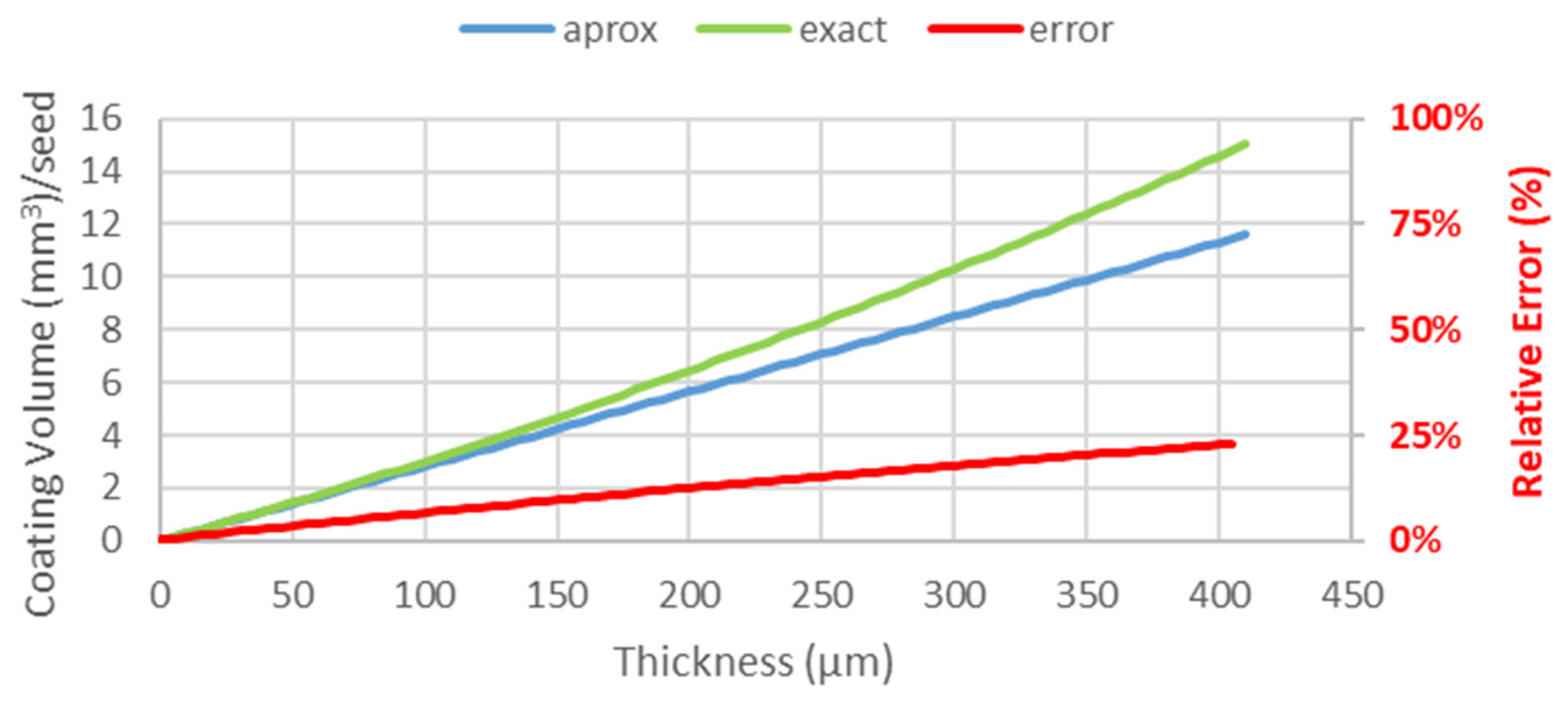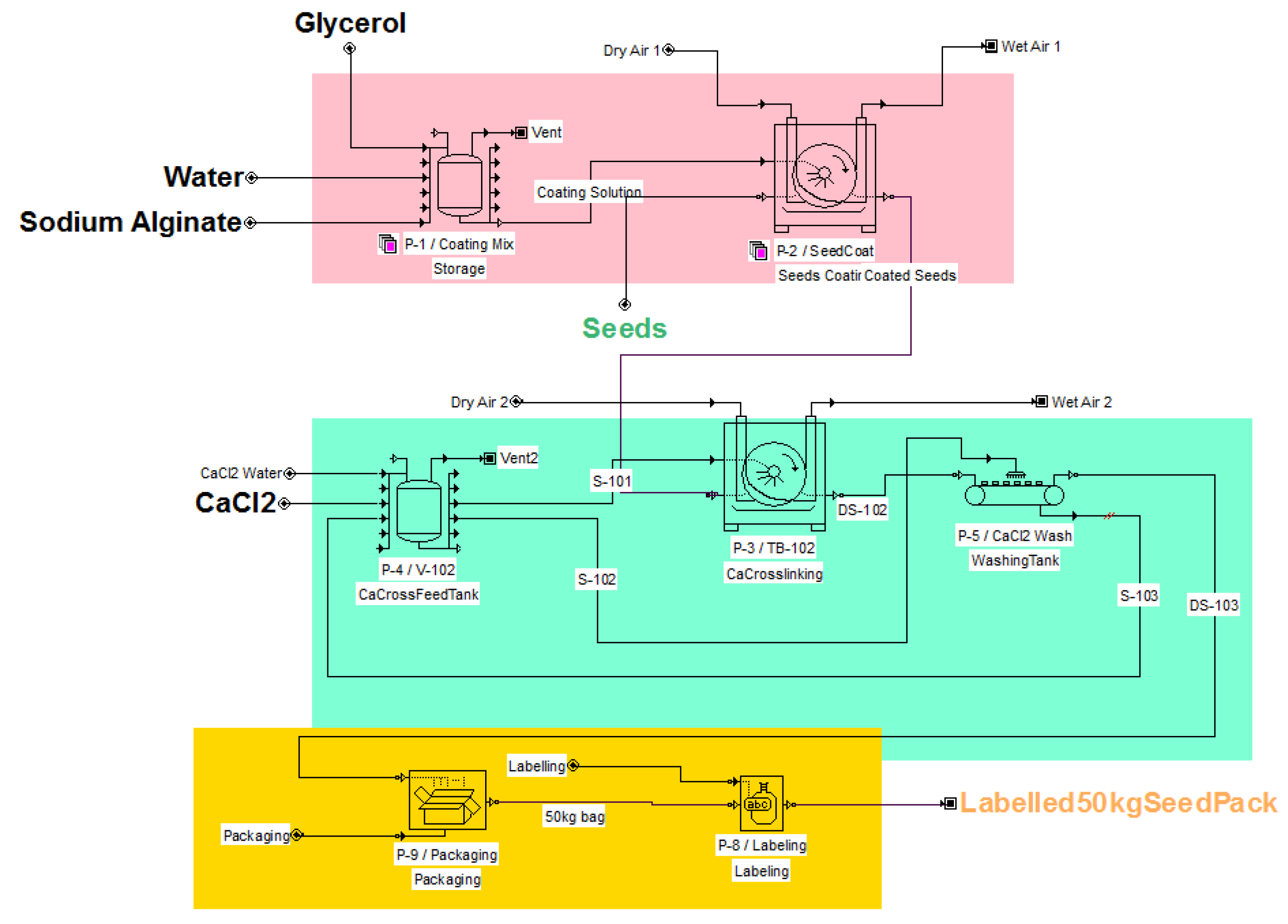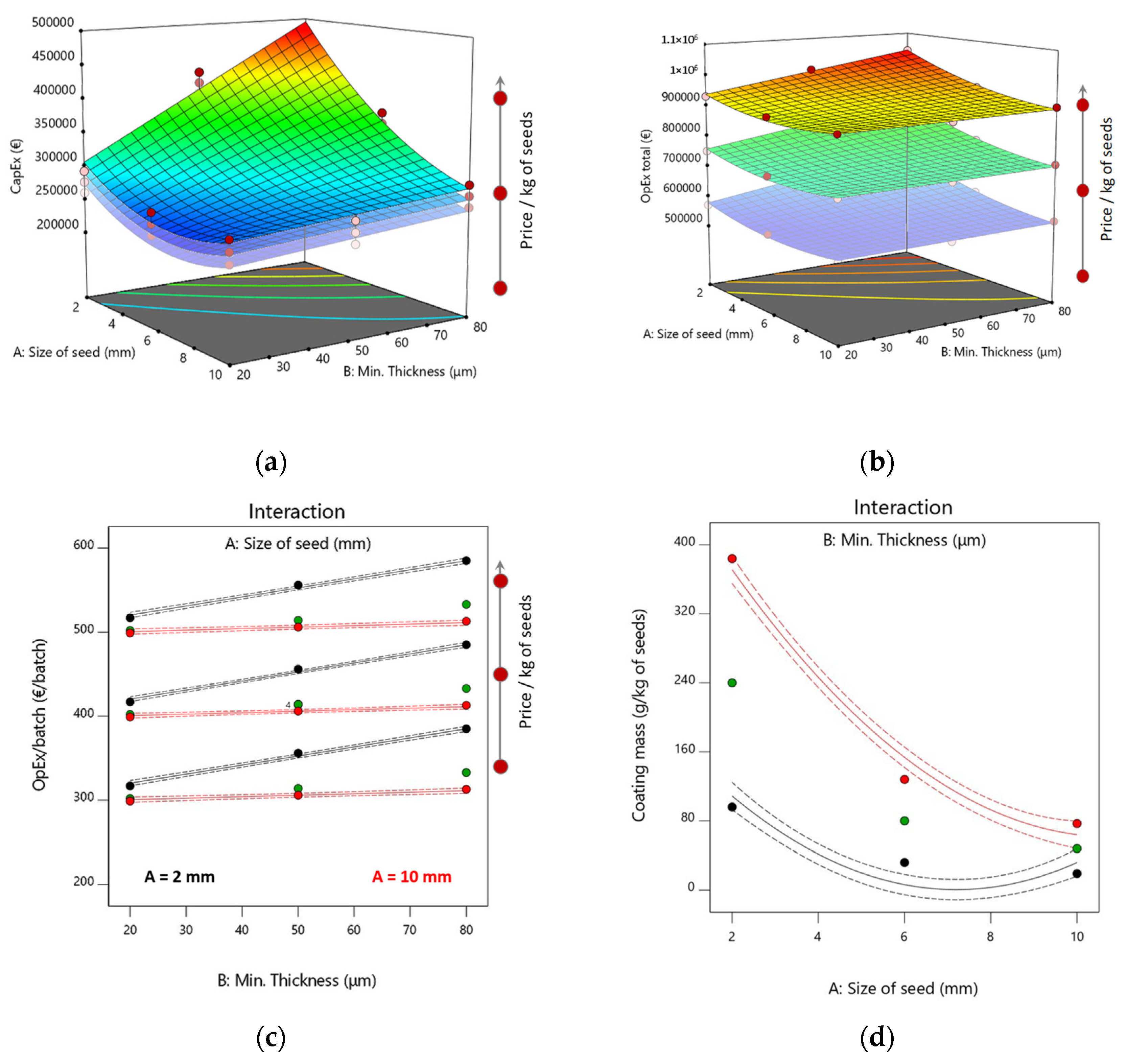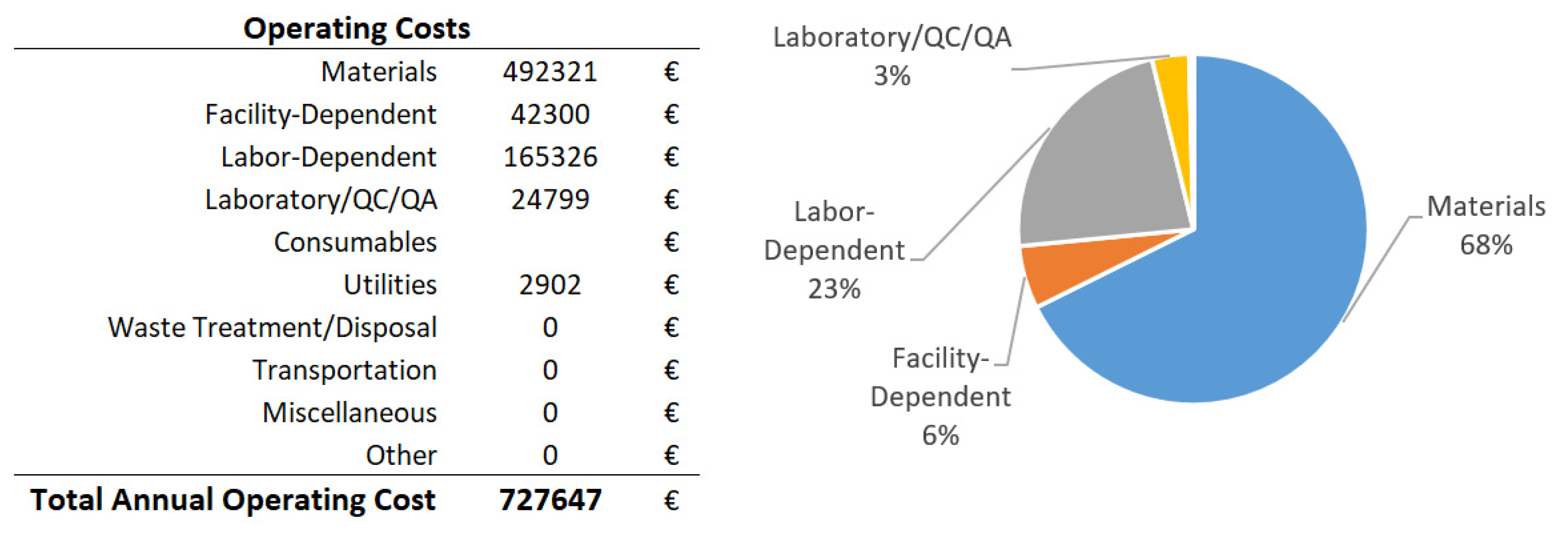Techno-Economic Analysis for the Coating of Seeds with Sodium Alginate Plasticized by Glycerol Using the Wurster Fluid-Bed Bottom Spray Process †
Abstract
1. Introduction
2. Methods
2.1. Process Simulation
2.2. Statistical Model to Evaluate the Effect of the Input Data on the Costs
3. Results and Discussion
4. Conclusions
Author Contributions
Funding
Institutional Review Board Statement
Informed Consent Statement
Data Availability Statement
Conflicts of Interest
Appendix A

References
- Coating Place Inc.—Our History. Available online: https://www.coatingplace.com/our-history/our-history.html (accessed on 13 August 2023).
- Wolkoff, H.N.; Pinchuk, G.; Shapiro, P.H. Design and Evaluation of a Miniature Air-Suspension Coating Apparatus. J. Pharm. Sci. 1968, 57, 317–321. [Google Scholar] [CrossRef] [PubMed]
- Davies, W.L.; Gloor, W.T. Batch production of pharmaceutical granulations in a fluidized bed I: Effects of process variables on physical properties of final granulation. J. Pharm. Sci. 1971, 60, 1869–1874. [Google Scholar] [CrossRef] [PubMed]
- Baveja, S.K.; Rao, K.V.R.; Singh, A. Design and evaluation of a miniature air-suspension coating apparatus. J. Pharm. Pharmacol. 1983, 35, 475–476. [Google Scholar] [CrossRef] [PubMed]
- Christensen, F.N.; Bertelsen, P. Qualitative description of the Wurster-based fluid-bed coating process. Drug Dev. Ind. Pharm. 1997, 23, 451–463. [Google Scholar] [CrossRef]
- Guignon, B.; Duquenoy, A.; Dumoulin, E.D. Fluid bed encapsulation of particles: Principles and practice. Dry. Technol. 2002, 20, 419–447. [Google Scholar] [CrossRef]
- Teunou, E.; Poncelet, D. Batch and continuous fluid bed coating–review and state of the art. J. Food Eng. 2002, 53, 325–340. [Google Scholar] [CrossRef]
- Trica, B.; Tritean, N.; Constantinescu-Aruxandei, D.; Oancea, F. Optimization of the Mung Bean Seed Coating with Alginate in a Bottom-Sprayed Wurster Fluidized Bed Coater. Coatings 2023, 13, 562. [Google Scholar] [CrossRef]
- Madlmeir, S.; Forgber, T.; Trogrlic, M.; Jajcevic, D.; Kape, A.; Contreras, L.; Carmody, A.; Liu, P.; Davies, C.; Sarkar, A. Quantifying the coating yield by modeling heat and mass transfer in a Wurster fluidized bed coater. Chem. Eng. Sci. 2022, 252, 117505. [Google Scholar]
- Hamed, E.; Sakr, A. Application of multiple response optimization technique to extended release formulations design. J. Control. Release 2001, 73, 329–338. [Google Scholar] [CrossRef]
- Shelukar, S.; Ho, J.; Zega, J.; Roland, E.; Yeh, N.; Quiram, D.; Nole, A.; Katdare, A.; Reynolds, S. Identification and characterization of factors controlling tablet coating uniformity in a Wurster coating process. Powder Technol. 2000, 110, 29–36. [Google Scholar] [CrossRef]
- Halecky, A.; Ren, N.; Lockwood, F.; Lu, J.; Wang, J. Correlation of the mechanical properties of seed coating films and dust-off, flowability, and plantability tests. In Proceedings of the 36th Symposium on Pesticide Formulation and Delivery Systems: Emerging Trends Building on a Solid Foundation, Tampa, FL, USA, 27–29 October 2015; ASTM International: West Conshohocken, PA, USA, 2016; pp. 183–201. [Google Scholar]
- Takekawa, M.; Moriwaki, R. Effects of seed coating with calcium peroxide on germination and instability in seedling establishment of directly sown rice plants in flooded paddy field. Bull. Hokkaido Prefect. Agric. Exp. Stn. 1979, 42, 1–9. [Google Scholar]
- Adams, A.F.R.; Lowther, W.L. Lime, inoculation, and seed coating in the establishment of oversown clovers. N. Z. J. Agric. Res. 1970, 13, 242–251. [Google Scholar] [CrossRef][Green Version]
- Kleinig, C.R. Emergence of Medicago tribuloides on moderately acid soils. Aust. J. Agric. Res. 1965, 16, 311–319. [Google Scholar] [CrossRef]
- Slininger, P.J.; Cauwenberge, J.E.V.; Bothast, R.J.; Weller, D.M.; Thomashow, L.S.; Cook, R.J. Effect of growth culture physiological state, metabolites, and formulation on the viability, phytotoxicity, and efficacy of the take-all biocontrol agent Pseudomonas fluorescens 2–79 stored encapsulated on wheat seeds. Appl. Microbiol. Biotechnol. 1996, 45, 391–398. [Google Scholar] [CrossRef]
- Amiet-Charpentier, C.; Gadille, P.; Digat, B.; Benoit, J.P. Microencapsulation of rhizobacteria by spray-drying: Formulation and survival studies. J. Microencapsul. 1998, 15, 639–659. [Google Scholar] [CrossRef] [PubMed]
- Brooker, N.L.; Lagalle, C.D.; Zlatanic, A.; Javni, I.; Petrovic, Z. Soy polyol formulations as novel seed treatments for the management of soil-borne diseases of soybean. Commun. Agric. Appl. Biol. Sci. 2007, 72, 35–43. [Google Scholar] [PubMed]
- Yu, X.; Wang, Z.; Sheng, S.; Xu, J. Effects of Atractylodes macrocephala seeds coated with SCF on field diseases. Zhong yao cai = Zhongyaocai = J. Chin. Med. Mater. 2002, 25, 230–231. [Google Scholar]
- Chikoye, D.; Fontem, L.A.; Menkir, A. Seed coating herbicide tolerant maize hybrids with imazapyr for Striga hermonthica (Del.) Benth control in the West African savanna. J. Food Agric. Environ. 2011, 9, 416–421. [Google Scholar]
- Simon-Delso, N.; Amaral-Rogers, V.; Belzunces, L.P.; Bonmatin, J.-M.; Chagnon, M.; Downs, C.; Furlan, L.; Gibbons, D.W.; Giorio, C.; Girolami, V. Systemic insecticides (neonicotinoids and fipronil): Trends, uses, mode of action and metabolites. Environ. Sci. Pollut. Res. 2015, 22, 5–34. [Google Scholar]
- Rundlöf, M.; Andersson, G.K.S.; Bommarco, R.; Fries, I.; Hederström, V.; Herbertsson, L.; Jonsson, O.; Klatt, B.K.; Pedersen, T.R.; Yourstone, J. Seed coating with a neonicotinoid insecticide negatively affects wild bees. Nature 2015, 521, 77–80. [Google Scholar] [CrossRef] [PubMed]
- Agustiany, E.A.; Rasyidur Ridho, M.; Rahmi Dn, M.; Madyaratri, E.W.; Falah, F.; Lubis, M.A.R.; Solihat, N.N.; Syamani, F.A.; Karungamye, P.; Sohail, A. Recent developments in lignin modification and its application in lignin-based green composites: A review. Polym. Compos. 2022, 43, 4848–4865. [Google Scholar] [CrossRef]
- Korbecka-Glinka, G.; Piekarska, K.; Wiśniewska-Wrona, M. The use of carbohydrate biopolymers in plant protection against pathogenic fungi. Polymers 2022, 14, 2854. [Google Scholar] [CrossRef] [PubMed]
- de Castro, V.A.; Duarte, V.G.O.; Nobre, D.A.C.; Silva, G.H.; Constantino, V.R.L.; Pinto, F.G.; Macedo, W.R.; Tronto, J. Plant growth regulation by seed coating with films of alginate and auxin-intercalated layered double hydroxides. Beilstein J. Nanotechnol. 2020, 11, 1082–1091. [Google Scholar] [CrossRef]
- Jarecki, W. Soybean response to seed coating with chitosan+ alginate/PEG and/or inoculation. Agronomy 2021, 11, 1737. [Google Scholar] [CrossRef]
- Tian, F.; Chen, W.; Cai’E, W.; Kou, X.; Fan, G.; Li, T.; Wu, Z. Preservation of Ginkgo biloba seeds by coating with chitosan/nano-TiO2 and chitosan/nano-SiO2 films. Int. J. Biol. Macromol. 2019, 126, 917–925. [Google Scholar] [CrossRef] [PubMed]
- de Castro e Silva, P.; Pereira, L.A.S.; Lago, A.M.T.; Valquíria, M.; de Rezende, É.M.; Carvalho, G.R.; Oliveira, J.E.; Marconcini, J.M. Physical-mechanical and antifungal properties of pectin nanocomposites/neem oil nanoemulsion for seed coating. Food Biophys. 2019, 14, 456–466. [Google Scholar] [CrossRef]
- Kasani, A.A.; Esmaeili, A.; Golzary, A. Software tools for microalgae biorefineries: Cultivation, separation, conversion process integration, modeling, and optimization. Algal Res. 2022, 61, 102597. [Google Scholar] [CrossRef]






| Min | Med | Max | |
|---|---|---|---|
| F1: Size of seed/diameter (mm) | 2 | 6 | 10 |
| F2: Min. coating thickness (µm) | 20 | 50 | 80 |
| F3: Price of seed (EUR/kg) | 3 | 5 | 7 |
| Min | Med | Max | |
|---|---|---|---|
| R1: Coating mass (g) | 26 | 269 | 512 |
| R2: CapEx (EUR) | 232,207 | 385,314 | 538,420 |
| R3: OpEx (EUR) | 544,836 | 815,281 | 1,085,726 |
| R4: OpEx (EUR)/batch | 301 | 456 | 611 |
Disclaimer/Publisher’s Note: The statements, opinions and data contained in all publications are solely those of the individual author(s) and contributor(s) and not of MDPI and/or the editor(s). MDPI and/or the editor(s) disclaim responsibility for any injury to people or property resulting from any ideas, methods, instructions or products referred to in the content. |
© 2023 by the authors. Licensee MDPI, Basel, Switzerland. This article is an open access article distributed under the terms and conditions of the Creative Commons Attribution (CC BY) license (https://creativecommons.org/licenses/by/4.0/).
Share and Cite
Trică, B.; Enache, A.; Oancea, F. Techno-Economic Analysis for the Coating of Seeds with Sodium Alginate Plasticized by Glycerol Using the Wurster Fluid-Bed Bottom Spray Process. Chem. Proc. 2023, 13, 5. https://doi.org/10.3390/chemproc2023013005
Trică B, Enache A, Oancea F. Techno-Economic Analysis for the Coating of Seeds with Sodium Alginate Plasticized by Glycerol Using the Wurster Fluid-Bed Bottom Spray Process. Chemistry Proceedings. 2023; 13(1):5. https://doi.org/10.3390/chemproc2023013005
Chicago/Turabian StyleTrică, Bogdan, Alin Enache, and Florin Oancea. 2023. "Techno-Economic Analysis for the Coating of Seeds with Sodium Alginate Plasticized by Glycerol Using the Wurster Fluid-Bed Bottom Spray Process" Chemistry Proceedings 13, no. 1: 5. https://doi.org/10.3390/chemproc2023013005
APA StyleTrică, B., Enache, A., & Oancea, F. (2023). Techno-Economic Analysis for the Coating of Seeds with Sodium Alginate Plasticized by Glycerol Using the Wurster Fluid-Bed Bottom Spray Process. Chemistry Proceedings, 13(1), 5. https://doi.org/10.3390/chemproc2023013005








